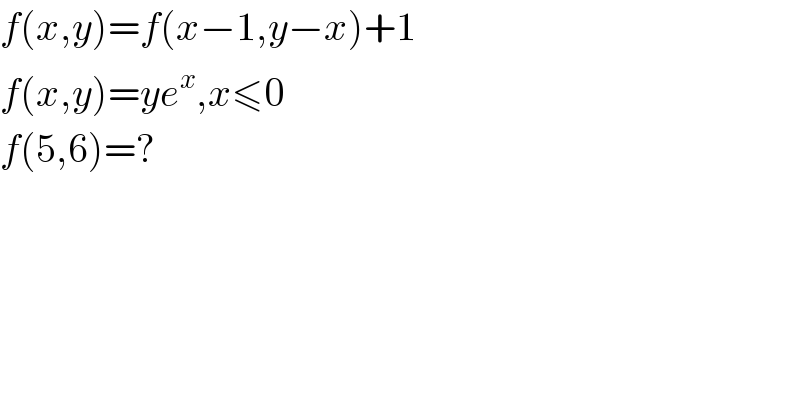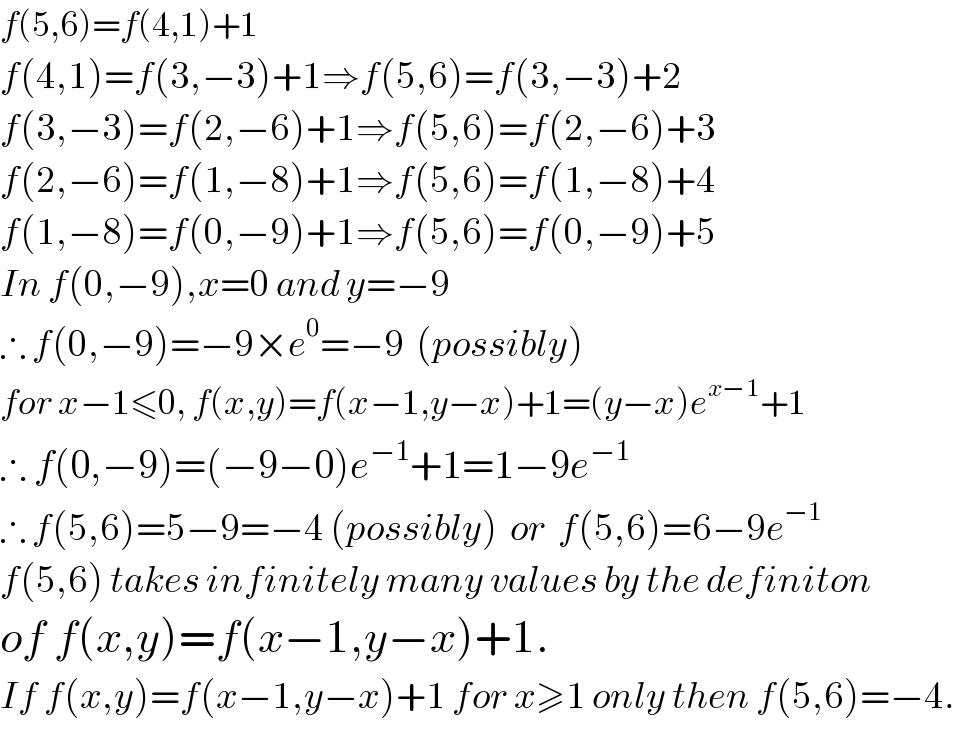
Previous in Relation and Functions Next in Relation and Functions
Question Number 2604 by 123456 last updated on 23/Nov/15

$${f}\left({x},{y}\right)={f}\left({x}−\mathrm{1},{y}−{x}\right)+\mathrm{1} \\ $$$${f}\left({x},{y}\right)={ye}^{{x}} ,{x}\leqslant\mathrm{0} \\ $$$${f}\left(\mathrm{5},\mathrm{6}\right)=? \\ $$
Answered by Yozzis last updated on 23/Nov/15

$${f}\left(\mathrm{5},\mathrm{6}\right)={f}\left(\mathrm{4},\mathrm{1}\right)+\mathrm{1} \\ $$$${f}\left(\mathrm{4},\mathrm{1}\right)={f}\left(\mathrm{3},−\mathrm{3}\right)+\mathrm{1}\Rightarrow{f}\left(\mathrm{5},\mathrm{6}\right)={f}\left(\mathrm{3},−\mathrm{3}\right)+\mathrm{2} \\ $$$${f}\left(\mathrm{3},−\mathrm{3}\right)={f}\left(\mathrm{2},−\mathrm{6}\right)+\mathrm{1}\Rightarrow{f}\left(\mathrm{5},\mathrm{6}\right)={f}\left(\mathrm{2},−\mathrm{6}\right)+\mathrm{3} \\ $$$${f}\left(\mathrm{2},−\mathrm{6}\right)={f}\left(\mathrm{1},−\mathrm{8}\right)+\mathrm{1}\Rightarrow{f}\left(\mathrm{5},\mathrm{6}\right)={f}\left(\mathrm{1},−\mathrm{8}\right)+\mathrm{4} \\ $$$${f}\left(\mathrm{1},−\mathrm{8}\right)={f}\left(\mathrm{0},−\mathrm{9}\right)+\mathrm{1}\Rightarrow{f}\left(\mathrm{5},\mathrm{6}\right)={f}\left(\mathrm{0},−\mathrm{9}\right)+\mathrm{5} \\ $$$${In}\:{f}\left(\mathrm{0},−\mathrm{9}\right),{x}=\mathrm{0}\:{and}\:{y}=−\mathrm{9} \\ $$$$\therefore\:{f}\left(\mathrm{0},−\mathrm{9}\right)=−\mathrm{9}×{e}^{\mathrm{0}} =−\mathrm{9}\:\:\left({possibly}\right) \\ $$$${for}\:{x}−\mathrm{1}\leqslant\mathrm{0},\:{f}\left({x},{y}\right)={f}\left({x}−\mathrm{1},{y}−{x}\right)+\mathrm{1}=\left({y}−{x}\right){e}^{{x}−\mathrm{1}} +\mathrm{1} \\ $$$$\therefore\:{f}\left(\mathrm{0},−\mathrm{9}\right)=\left(−\mathrm{9}−\mathrm{0}\right){e}^{−\mathrm{1}} +\mathrm{1}=\mathrm{1}−\mathrm{9}{e}^{−\mathrm{1}} \\ $$$$\therefore\:{f}\left(\mathrm{5},\mathrm{6}\right)=\mathrm{5}−\mathrm{9}=−\mathrm{4}\:\left({possibly}\right)\:\:{or}\:\:{f}\left(\mathrm{5},\mathrm{6}\right)=\mathrm{6}−\mathrm{9}{e}^{−\mathrm{1}} \\ $$$${f}\left(\mathrm{5},\mathrm{6}\right)\:{takes}\:{infinitely}\:{many}\:{values}\:{by}\:{the}\:{definiton} \\ $$$${of}\:{f}\left({x},{y}\right)={f}\left({x}−\mathrm{1},{y}−{x}\right)+\mathrm{1}. \\ $$$${If}\:{f}\left({x},{y}\right)={f}\left({x}−\mathrm{1},{y}−{x}\right)+\mathrm{1}\:{for}\:{x}\geqslant\mathrm{1}\:{only}\:{then}\:{f}\left(\mathrm{5},\mathrm{6}\right)=−\mathrm{4}. \\ $$
Commented by prakash jain last updated on 23/Nov/15

$$\mathrm{The}\:\mathrm{font}\:\mathrm{looks}\:\mathrm{really}\:\mathrm{small}.\: \\ $$
Commented by Yozzis last updated on 23/Nov/15

$${I}\:{don}'{t}\:{know}\:{why}\:{this}\:{has}\:{happened}... \\ $$
